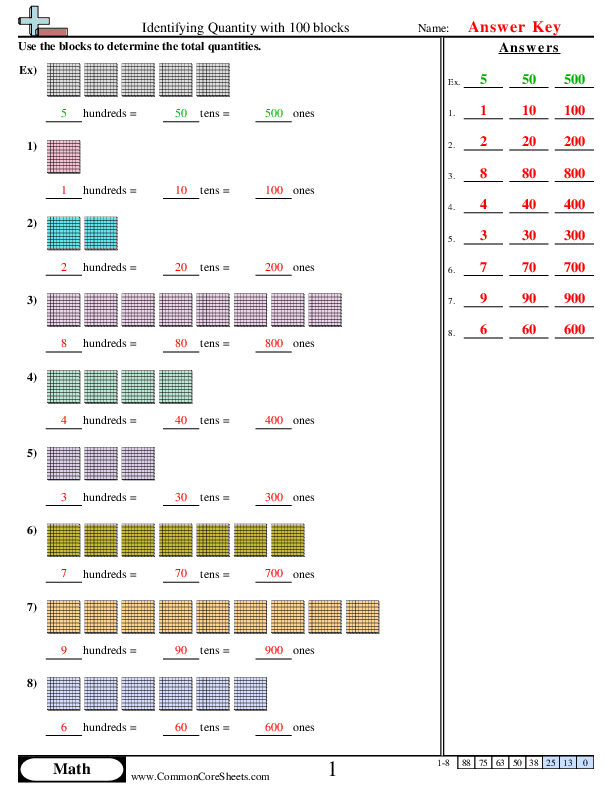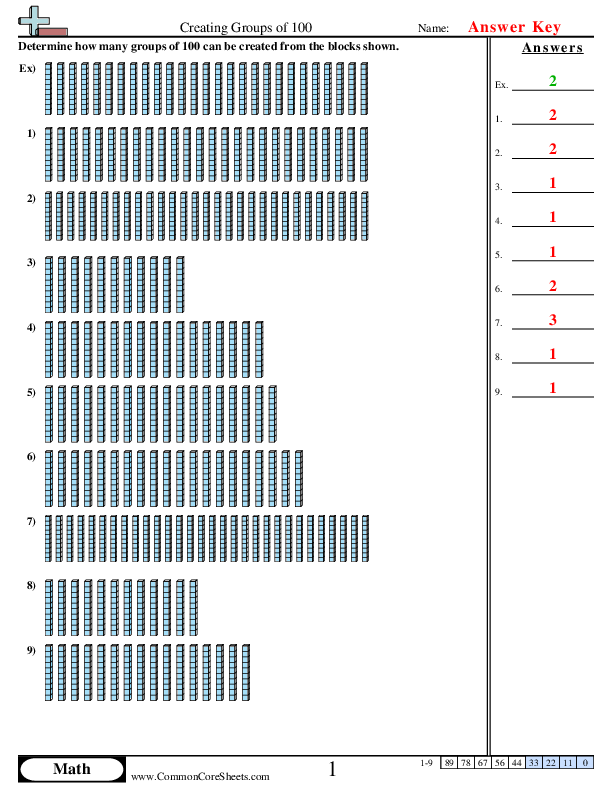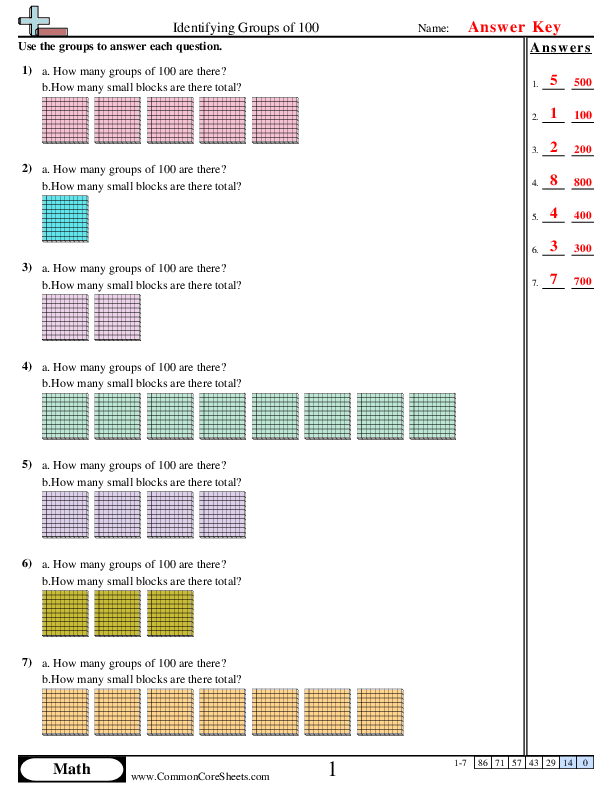Browse Sheets By Problem Type
×

Identifying Quantity with 100 blocks.
2nbt1a


×
Description:
"This worksheet is designed to reinforce children’s understanding of numbers and quantities in hundreds, tens, and ones format. Featuring eight engaging math problems, the worksheet challenges learners to identify the value of hundreds, tens, and ones in numbers like 300, 500, and 700. Adaptable for various learning styles, its format can be customized, used as flash cards, or incorporated into distance learning curriculums, offering a versatile tool to strengthen foundational math skills in an engaging way."

×
Student Goals:
Master Basic Math ConceptsStudents should be able to have a firm grasp of basic math concepts, particularly the value of numbers and the quantity they represent. They should understand the number system, identify and differentiate between hundreds, tens, and ones. This foundational knowledge will aid them in tackling more complex math equations in the future.Enhance Critical Thinking and Problem-solving SkillsUpon completion of the worksheet, students should be able to apply learned concepts to solve problems. By determining the quantity that each block set of hundreds, tens, and ones represents, they enhance their critical thinking and problem-solving skills, which are invaluable in everyday life and across academic disciplines.Grow Counting and Calculation SkillsAfter completing the worksheet, students should show significant improvement in their counting and calculation skills. They get to practice counting by hundreds up to a thousand, reinforcing their ability to count and calculate quickly and accurately.Develop Understanding of Place ValuesThe teaching of hundreds, tens, and ones forms the core of the place value system, which is a fundamental concept in arithmetic and number theory. Students should be able to recognize and understand how place values work and apply this knowledge when reading and composing numbers.Boost Cognitive Ability and FocusThe worksheet targets the enhancement of children's cognitive abilities and their focus. By following the set of problems and solving them, students train their brain to focus, maintain attention, and carry out critical cognitive functions.Build Confidence in MathSuccessfully completing the worksheet should instill confidence in students, allowing them to approach Math's future tasks and challenges with less fear and hesitation. This confidence can enhance their overall academic performance and attitude towards learning.



Creating Groups of 100
2nbt1a


×
Description:
"This worksheet is designed for children to enhance their math skills by creating groups of 100. Comprising of 9 unique problems, it simplifies numerical concepts into engaging tasks. Featuring customization, it can be transformed into flash cards, serving as an effective tool for distance learning. With its flexibility and interactivity, this resource promotes fun while learning mathematics."

×
Student Goals:
ComprehensionBy completing this worksheet, students should have developed an understanding of how to create groups of 100. This fundamental mathematical concept enables them to subdivide large numbers into easily manageable groups, greatly improving their numeric comprehension skills. They would also have developed mental math strategies for dealing with numbers, making it easier for them to perform quick calculations in their heads.Critical ThinkingStudents should showcase an enhanced ability to solve problems. They would be able to strategize, deduce, and sift through various possibilities to determine the correct groupings of numbers. This critical thinking capability is not exclusive to math alone. Properly cultivating it can transfer seamlessly into other subjects or areas where problem-solving abilities are needed. This worksheet helps in tackling complex problems by breaking them down into smaller, manageable parts.Number FluencyThe completion of this worksheet should correlate to increased numerical fluency. That is, they would demonstrate a strong familiarity with numbers, and their proficiency in manipulating them should be evident. Participating in exercises, where they need to create groups of 100, would have effectively reinforced the concept of the base-10 number system, thereby ameliorating their numerical agility.Confidence and EncouragementBy completing these tasks, students would have taken steps towards improved confidence in their mathematical abilities. The sense of accomplishment found in successfully creating groups of 100 would serve as a motivational boost, encouraging them to engage further with mathematical problem-solving activities. This can be crucial in setting a robust foundation for more complex mathematical theories and numerical applications in the future.Integration of KnowledgeBeyond gaining familiarity with numbers, students would learn how to integrate different parts of knowledge in a cohesive manner. They would understand number operations, connections among numbers, and how they can break down and group numbers in varied ways for different purposes, thus showing evidence of considerable cognitive growth in number sense. This worksheet stands as a stepping stone in the journey to develop sophisticated numerical capabilities that are the backbone of higher-level mathematic comprehension.



Identifying Groups of 100
2nbt1b


×
Description:
"This worksheet is designed to boost children's mathematical skills by identifying groups of 100. Comprising seven problems, each with two questions, students are asked to define the number of groups that make up 100 and determine the total number of small blocks. Highly versatile, this tool can be tailored to individual learning needs, transformed into engaging flashcards, or incorporated into distance learning platforms to create a flexible, interactive, and stimulating learning environment."

×
Student Goals:
Understanding Quantity GroupingsAfter completing this worksheet, students should be able to understand the concept of quantity groupings, specifically centered around the number 100. They will learn to conceptualize what it means for quantities to be grouped into hundreds, enabling them to more readily grapple with larger numbers.Counting and Calculation SkillsCompleting the worksheet should improve students' ability to count and perform basic mathematical operations. The consistent repetition will enable them to become more adept at quickly identifying groups of 100, improving their mental arithmetic skills.Developing Problem Solving AbilitiesStudents will learn how to approach and solve problems. By working through a variety of tasks, students will gain the ability to take information, process it, and determine a solution based on that information. This facilitates the development of logical thinking and analytical skills.Grasping Mathematical ConceptsUpon completing the worksheet, students will have a better grasp on larger mathematical concepts. This includes understanding the relationships between numbers, the importance of grouping in mathematics, and how these concepts relate to each other within the subject of mathematics. This understanding will prove invaluable as students progress to more complex topics.Increasing Numeracy ConfidenceAs students work through the problems and become more comfortable with the concept of grouping into hundreds, they will increase their confidence in their numeracy abilities. This self-assurance is not only important for their ongoing mathematical education but also contributes to their general academic self-efficacy.Understanding Number RelationshipsBy focusing on identifying groups of 100, students will gain a deeper understanding of the relationships between numbers. They will improve their comprehension of how quantities and numbers can be broken down and grouped, building a robust foundation for future mathematical endeavors.Practicing Application of KnowledgeLastly, accomplishing this worksheet allows students to practice applying their new knowledge. From recognizing groups of 100 to calculating the total number of smaller blocks, students will see how the principles they are learning can be directly applied in mathematical problems, reinforcing the practicality of the skills they are being taught.




